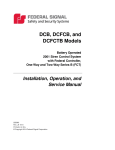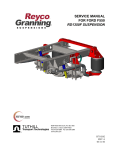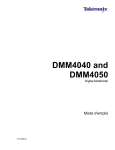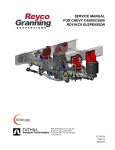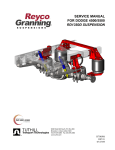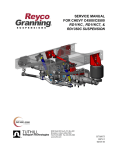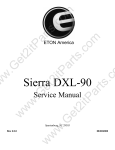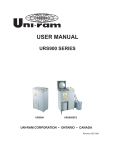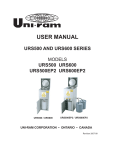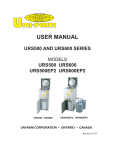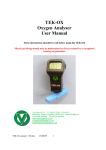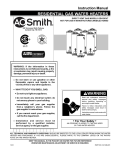Download Detecto-Pak III - Heath Consultants
Transcript
HEATH Detecto-Pak™ III User’s Manual Heath Consultants Incorporated Houston, TX 713/844-1300 Fax: 713/844-1309 1-800-HEATH-US www.heathus.com Heath....Leadership, Innovation, Performance Then, Now and Tomorrow INTRODUCTION The Heath Detecto-Pak® III Flame Ionization Hydrocarbon Detector is designed to withstand normal field use and provide sensitive indication to the presence of hydrocarbon vapors. This instruction manual is divided into nine chapters. Each chapter is designed to assure that the operator will obtain the best use of the Heath Detecto-Pak® III. Chapter One, Heath Detecto-Pak® III FEATURES, should be required reading for all operating personnel prior to using the Heath Detecto-Pak® III. Chapter Five, OPERATING THE Heath Detecto-Pak® III, outlines the steps necessary to make the instrument operational. Other chapters cover topics such as troubleshooting procedures, periodic maintenance, applications, etc. FUNCTION The Heath Detecto-Pak® III Flame Ionization Hydrocarbon Detector is designed to detect and measure the presence of hydrocarbons (calibrated for methane). The instrument has five sensitivity ranges: 10, 50, 100, 1,000 (1K), and 10,000 (10K) ppm. Also available is an optional unit capable of detecting up to 100,000 ppm (dilution value). This instruction manual describes the operation of the instrument and provides limited maintenance information. The Heath Detecto-Pak® III, when properly maintained, will provide reliability and ease of operation for many years. i ii WARNING EXPLOSIVE GAS MIXTURES CAN CAUSE SERIOUS INJURY OR DEATH. INHALATION OF VAPORS CAN CAUSE HEALTH IMPAIRMENT. WARNING IT IS ESSENTIAL THAT USERS OF THIS INSTRUMENT READ, UNDERSTAND, AND FOLLOW THE INSTRUCTIONS FOR OPERATION AND MAINTENANCE AND THE PRECAUTIONS CONTAINED IN THIS MANUAL TO INSURE THE INSTRUMENT IS USED IN A PROPER AND SAFE MANNER. WARNING DO NOT ATTEMPT TO REPAIR THE INTERNAL FUEL REGULATOR. DISASSEMBLY COULD CAUSE DAMAGE TO THE Heath Detecto-Pak® III. WARNING DO NOT ATTEMPT TO REPAIR THE FUEL OR CALIBRATION CYLINDER/VALVE ASSEMBLY. WARNING THE BATTERY MUST BE CHANGED OR CHARGED IN AN AREA KNOWN TO BE NON-FLAMMABLE TO REDUCE THE RISK OF IGNITING A FLAMMABLE ATMOSPHERE. iii TABLE OF CONTENTS INTRODUCTION ....................................................... FUNCTION ................................................................ WARNINGS ............................................................... TABLE OF CONTENTS ............................................. i i iii v CHAPTER I Detecto-Pak® III FEATURES Complete System ...................................................... Figure 1 ............................................................... Instrument ................................................................. Probe, Sample ........................................................... Carrying Strap, with pad ............................................ Gauge Adapter .......................................................... Fuel Transfiller ........................................................... Carrying Case, System .............................................. Fuel Cylinders ............................................................ “O” Ring for Fuel Cylinder Valve ................................ Battery Charger ......................................................... Instruction Manual ..................................................... Filtration ..................................................................... “O” Ring Lubricant ..................................................... Additional Features .................................................... Optional Accessories ................................................. 1 1 2 2 3 3 3 4 4 4 5 5 5 5 5 6 CHAPTER II FUEL MOTHER TANKS/FUEL CYLINDERS Fuel Gas Mixture ....................................................... Transfilling Fuel Cylinders ......................................... Figure 2 ............................................................... Ordering Fuel Mother Tanks ...................................... Storing Fuel Mother Tanks or Cylinders ..................... Shipping Fuel Mother Tanks or Cylinders .................. v 8 8 9 10 11 11 CHAPTER III CALIBRATION MOTHER TANKS/ CALIBRATION CYLINDERS Calibration Gas Mixtures ........................................... Transfilling Calibration Cylinders ............................... Figure 3 ............................................................... 12 12 13 CHAPTER IV CHARGING SYSTEMS Nickel-Cadium(NiCad) Rechargeable Battery............. Battery Charger ......................................................... Charging Procedure .................................................. General Information - Nickel-Cadmium Battery.......... 15 15 16 17 CHAPTER V OPERATING THE Heath Detecto-Pak® III Figure 4 ............................................................... Figure 4.1 ............................................................ Controls ..................................................................... Operating Procedures ............................................... Shutdown Procedures ............................................... 18 19 20 22 25 CHAPTER VI CALIBRATION Calibration Gas .......................................................... Calibration Procedures .............................................. Calibration Access (Figures 5 & 6) ............................ 26 27 30 CHAPTER VII APPLICATIONS FOR THE Detecto-Pak® III Gas Distribution Systems .......................................... vi 32 32 Gas Transmission Companies .................................. LP-Gas (Propane) Companies .................................. Industrial/Manufacturing/ Refining Facilities .............. Telephone Companies .............................................. Housing Authorities/Apartment Complexes/ Mobile Home Parks/ Master Meter Facilities ............. Sanitary Landfill/Waste Storage/ Environmental Study Areas ............................................................... 32 33 33 33 33 CHAPTER VIII MAINTENANCE INFORMATION Troubleshooting Procedures and Periodic Maintenance ............................................................. Troubleshooting the Instrument ................................. Figure 7 ............................................................... Filter Replacement .................................................... Parts List ................................................................... 34 35 36 37 37 CHAPTER IX SERVICE INFORMATION Warranties and Warranty Repair ............................... Customer Service, Manufacturing and Instrument Repair Locations........................................................ Notes ......................................................................... vii 42 44 45 FEATURES FEATURES Chapter I Detecto-Pak® III FEATURES: This chapter describes the features of the Detecto-Pak® III. Please refer to Figure 1 for illustration of individual parts. Detecto-Pak® III Complete (Part No. 100023-0, 110 VAC) (Part No. 100023-2, 220 VAC) 1 2 8 3 9 4 10 5 11 6 7 12 Figure 1 1. Carrying Case, System (Part No. 0618415) 2. Instrument Only (Part No. 0618313) 3. Instruction Manual (Part No. 0618307) 4. Filters, Pkg/100 (Part No. 0110163) 5. “O” Ring Lubricant (Part No. 0514885) 6. “O” Rings, (Pkg/10) (Part No. 0514966) 7. Gauge Adapter (Part No. 0618302) 8. Carrying Strap W/Pad (Part No. 100472-0) 9. Battery Charger (Auto.) (Part No. 0618305, 110VAC) 10. Fuel Cylinder (2 included) (Part No. 0618303) 11. Fuel Transfiller (Part No. 0514937) 12. Probe, Sample (Part No. 0111006) 1 FEATURES INSTRUMENT Sensitivity Ranges: Audible Alarm, continuous: Audible Alarm, pulsating: 0-10, 0-50, 0-100, 0-1,000 (1K), and 0-10,000 (10K) ppm. (Optional range of 100,000 ppm(dilution value) is available. Continuous alarm indicates flame is out. Pulsating alarm indicates signal level above approximately 35 to 45% full meter scale. Fuel Cylinder Pressure Indicator: Gauge 0-3,000 psig. Fuel Regulator, Internal: Fuel Cylinder Holder: Weight of Instrument: Inlet Pressure, 0-1,750 psig; Outlet Pressure, 22-42 psig; factory set per instrument w/1,000 psig in fuel cylinder. Holder located inside instrument to carry fuel cylinder. See opening at end of instrument. 7 lbs. (3.2 kg), Operating. PROBE, Sample Adjustable Length: 25 to 41 inches (63 to 104 cm) Weight: 12 oz. (.340 kg) 2 FEATURES CARRYING STRAP WITH PAD Strap: Strap facilitates carrying instrument over shoulder. Pad: Pad cushions shoulder. Weight: 6.4 oz. (.181 kg) GAUGE ADAPTER Gauge Adapter: Used to indicate outlet pressure setting of internal regulator. Weight: 5.6 oz. (.159 kg) FUEL TRANSFILLER Fuel Transfiller: Used for refilling fuel cylinders. Pressure Indicator: Gauge 0-3,000 psig Restrictor, Internal: Prevents pressure surge when filling cylinders. Purge Valve: Relieves pressure when filling cylinder is complete. Weight: 15.5 oz. (.439 kg) 3 FEATURES CARRYING CASE, System Dimensions: 24 x 20.5 x 11 inches (61 x 52 x 28 cm) Weight (Empty): (Filled): 17 lbs. (7.7 kg) 31 lbs. (14.1 kg) Total weight in shipping carton: 34 lbs. (15.4 kg) FUEL CYLINDERS Color: Black, DOT Rated 3E1800 Volume: 100 cubic centimeters (approximate) Maximum Working Pressure: 1,750 psig Weight: 1 lb. (.453 kg) “O” RINGS FOR FUEL CYLINDER VALVE “O” Rings: Supplied as spares for Fuel Cylinder Valves. Dimensions: .145 ID x .070 CS inches(.370 x .178 cm). Material: Buna-N. 4 FEATURES BATTERY CHARGER Automatic Reduction: 16 hours to full charge Power: 110 VAC, 60 Hz Output: 14.5 VDC at 60ma INSTRUCTION MANUAL Item refers to this Instruction Manual. FILTRATION Replaceable Filters: Part No. 0110163, Pkg/100 or Part No. 0110683, Pkg/500 “O” RING LUBRICANT Lubricant: supplied for lubrication of “O” Rings on Fuel Cylinder Valves. ADDITIONAL FEATURES (not shown) Sample Intake Rate: Pump, 2,000 cc per minute, (2 SLPM) nominal. 5 FEATURES Ignition Type: Piezo electric spark Battery Indicator: Needle indication (three color) on instrument ppm meter shows battery status. Power Supply: Internal, rechargeable NiCad Battery, 12 VDC, 60 mah. Fuel Consumption: Varies per instrument fuel setting, 40% Hydrogen - 60% Nitrogen at 22-42 psig. Daily Operating Life: Life is eight hours with fully-charged battery and two fuel cylinders filled to 1,750 psig. OPTIONAL ACCESSORIES Calibration Kit: Calibration Cylinder Transfiller: Pressure Indicator: This Calibration Kit is available to field calibrate the Heath Detecto-Pak® III to ensure proper sensitivity levels. Included calibration cylinder filled to approx. 1500 ! 200 psig of 100 ! 10 ppm methane, balance air. (Part No. 0123309-0) Used to refill above calibration gas cylinder (Part No. 0124601) Gauge 0-3,000 psig 6 FEATURES Restrictor, Internal: Prevents pressure surge when filling cylinders. Purge Valve: Relieves pressure when filling of cylinder is complete. 7 FUEL Chapter II FUEL MOTHER TANKS, FUEL CYLINDERS: This Chapter discusses, in detail, the proper steps to take in transferring fuel to the fuel cylinder. Recommendations for ordering fuel mother tanks, along with proper storage, are also discussed. Fuel Gas Mixture Heath Consultants suggest only a certified mixture of 40% hydrogen/60% nitrogen gas with less than .5 ppm of hydrocarbon be used in the Detecto-Pak® III. Transfilling Fuel Cylinders Heath Consultants Incorporated does not sell gas. Please see your local certified gas vendor. Heath assumes no liability in the refilling of fuel cylinders. If you wish to refill your own fuel cylinders, caution must be exercised during the refilling process. It is also recommended that all safety precautions be used in the handling of high-pressure, compressed flammable gases during the refilling process. To refill the fuel cylinders, connect the fuel transfiller to a fuel mother tank, then attach a non-contaminated fuel cylinder to the transfiller. See (Figure 2) and “**NOTE**” in this Section. 8 FUEL Mother Tank, Transfiller & Fuel Cylinder Connected for Transfilling Figure 2 1. Remove the safety cap or caps from the fuel mother tank. 2. Very slowly, open valve on the fuel mother tank a very small amount (crack). Then close it immediately. This will clean (blow) any contaminants out of the valve. 3. Firmly secure the hex nut on the transfiller to the fuel mother tank valve outlet using an appropriate wrench. (Note: notches in hex nut body indicate the nut threads are “Reverse Cut” threads.) 4. Finger tighten knurled nut on transfiller to valve outlet on fuel cylinder. 5. Close bleed off valve on transfiller by turning it completely clockwise. 9 FUEL 6. Slowly open fuel mother tank valve counterclockwise until the pressure gauge on the transfiller continues to rise, or approximately one-half of a turn open. 7. Observe transfiller pressure gauge and turn off fuel mother tank valve at 1750 psig or when the pressure gauge stops rising below 1750 psig level (determined by fuel mother tank internal pressure). DO NOT EXCEED 1750 psig pressure in the fuel cylinder. 8. Open bleed off valve on transfiller to eliminate pressure in transfiller. 9. Loosen knurled nut with finger pressure and remove fuel cylinder. 10. Remove transfiller from fuel mother tank, replace safety cap or caps, and safely store fuel mother tank. Ordering Fuel Mother Tanks Heath Consultants does not sell gas. When ordering a mother tank of fuel, it is recommended that only a certified mix of 40% hydrogen/60% nitrogen with less than .5 ppm of hydrocarbon be requested. **NOTE** When ordering, it is extremely important to specify CERTIFIED. This helps ensure quality gas. Not ordering CERTIFIED gas increases the risk of not securing a 40% H2 (hydrogen)/ 60% N2 (nitrogen) mix of less than (0.5) ppm hydrocarbon background. See Chapter Eight for an example of a negative effect. 10 FUEL Suppliers of Fuel Gas Mixtures: The following companies can supply the proper fuel mixtures in fuel mother tanks. This list is not intended as an endorsement, and other suppliers may be available. If you are unable to locate a fuel source, please contact Heath Customer Service: 1-800-432-8487. !Airco Scientific Gas Products !Alphagaz Scott Specialty Gases !MG Industries **NOTE** !Linde Matheson Gas Products !Liquid Carbonic Air Products (See Chapter Five, “IMPORTANT,” covering high altitude operation for special instructions.) Storing Fuel Mother Tanks or Cylinders The fuel mother tanks or fuel cylinders must be stored in accordance with D.O.T. and/or OSHA regulations. Simply stated, the regulations that apply are ones restricting storage of compressed, flammable gases near stored oxidizing agents such as compressed oxygen. Also applicable are regulations in regard to protecting the tanks from unauthorized tampering and/or mechanical damage. Shipping Fuel Mother Tanks or Cylinders Fuel mother tanks or fuel cylinders contain compressed, flammable gas and must be shipped as hazardous cargo according to D.O.T. and/or OSHA regulations. Fuel gas mixtures are flammable when mixed with air or oxygen. They must be shipped by motor freight or other freight services that permit shipment of compressed, flammable gases. In all cases, special labeling notation and documentation is required. (Refer to your Company’s Procedures or see the latest edition of “Hazardous Material Regulations of the Department of Transportation.”) 11 CALIBRATION TANKS/CYLINDERS Chapter III CALIBRATION MOTHER TANKS, CALIBRATION CYLINDERS: This Chapter discusses, in detail, the proper steps to take in transferring calibration gas to a calibration cylinder. Also discussed are recommendations for ordering and proper storage of calibration gas mother tanks. Calibration Gas Mixtures The calibration gas is comprised of a mixture of 100 ppm + 10% methane, balance zero air. The calibration gas mixture is drawn into the instrument at the inlet of the filter housing to ensure proper sensitivity level. (See Chapter Six for a detailed explanation of this method.) Transfilling Calibration Cylinders Heath Consultants Incorporated assumes no liability in the refilling of calibration cylinders. If you wish to refill your own calibration cylinders, caution must be exercised during the refilling process. It is also recommended that all safety precautions be used in the handling of high-pressure compressed, flammable gases during the refilling process. To refill the calibration cylinder, connect the calibration transfiller to a calibration mother tank, then attach a non contaminated calibration cylinder to the Transfiller. See (Figure 3). 12 CALIBRATION TANKS/CYLINDERS Mother Tank, Transfiller & Calibration Cylinder Connected for Transfilling Figure 3 1. Remove the safety cap or caps from the calibration mother tank. 2. Slowly open valve on the calibration mother tank a very small amount (crack). Then close it immediately. This will clean (blow) any contaminants out of the valve. 3. Firmly secure the hex nut on the calibration transfiller to the calibration mother tank valve outlet using an appropriate wrench. (Note: notches in hex nut body indicate that the nut threads are “Reverse Cut” threads.) 4. Tighten small hex nut on calibration transfiller to valve outlet on calibration cylinder. 5. Close bleed off valve on calibration transfiller by turning it completely clockwise. 13 CALIBRATION TANKS/CYLINDERS 6. Slowly open calibration mother tank valve counterclockwise until the pressure gauge on the calibration transfiller continues to rise, or approximately one-half of a turn open. 7. Observe calibration transfiller pressure gauge and turn off calibration mother tank valve at 1750 psig or when the pressure gauge stops rising below 1750 psig level (determined by calibration mother tank internal pressure). DO NOT EXCEED 1750 psig pressure in the calibration cylinder. After cylinder is filled, turn valve to “off” position 8. Open bleed off valve on calibration transfiller to eliminate pressure in calibration transfiller. 9. Loosen small hex nut and remove calibration cylinder. 10. Remove calibration transfiller from calibration mother tank, replace safety cap or caps, and safely store calibration mother tank. 14 CALIBRATION TANKS/CYLINDERS Chapter IV CHARGING SYSTEMS: The Heath Detecto-Pak® III is supplied with a rechargeable nickelcadmium battery. The battery is located inside the portable instrument and is designed to carry an energy supply sufficient to power the instrument for at least eight (8) hours of operation when fully charged. Part of the charging system includes an approved, automatic electronically controlled battery charger to recharge the nickelcadmium battery. Outside the USA, when required, a 220 VAC, 50 Hz to 110 VAC converter for your battery charger is available. Because of a wide range of 220 VAC receptacles encountered around the world, the customer must provide an adapter on the input side of the converter to fit the 220 VAC receptacle. Nickel-Cadmium (NiCad) Rechargeable Battery Because of electrical and chemical losses and the fact the battery discharges while being used, more energy must be put back into the NiCad battery than is drawn from it. Normally, it takes 12 to 16 hours of charging time to completely recharge a nickel-cadmium battery. If properly cared for, the nickel-cadmium battery should last throughout numerous cycles of regular use. Battery Charger The approved battery charger supplied with the Heath DetectoPak® III is an automatic, electronic type charger. After the battery charger has been plugged into the Detecto-Pak® III for 16 hours, the charger will automatically reduce itself down to float mode. The float mode will maintain a charge in the battery as long as it is 15 CHARGING SYSTEMS connected to the charger. We recommend that the Detecto-Pak® III be connected to the battery charger whenever it is not in use. This will ensure the battery is charged and the instrument is ready to use when required. Charging Procedure WARNING THE BATTERY MUST BE CHANGED OR CHARGED IN AN AREA KNOWN TO BE NONFLAMMABLE TO REDUCE THE RISK OF IGNITING A FLAMMABLE ATMOSPHERE. Set the Heath Detecto-Pak® III instrument ON-OFF switch to “OFF.” Plug the battery charger into a 120 VAC receptacle, then plug the battery charger output plug into the charge jack on the Detecto-Pak® III. If connected in the correct sequence, the charger is on and in the high charge mode. CHARGING TIME: Normally, a 12 to 16 hour battery charging period is required if the instrument has been operated for 8 to 10 hours. For other charging times, use a 1.5 to 1 charge-time to usetime. EXAMPLE: If you use the instrument for 4 hours, charge the battery for approximately 6 hours to completely recharge it, then the approved battery charger will automatically reduce the charge rate down to a float mode. 16 CHARGING SYSTEMS General Information - Nickel Cadmium Battery 1. We recommend that a new replacement nickel-cadmium battery be cycled two (2) times before regular use. First, fully charge the battery, then discharge the battery by operating the instrument 8 to 10 hours or until it ceases functioning. Next, Fully recharge for at least 16 hours. 2. Put the nickel-cadmium battery through a charge/discharge cycle at least once a month when the instrument is not in use. Nickel-cadmium batteries function best when frequently used. 3. Only use a Heath Consultants supplied nickel-cadmium battery and accompanying approved battery charger as they are matched for optimum performance and safety. 4. Do NOT use a nickel-cadmium battery when it is fully discharged. When the battery is depleted, it must be recharged before use. 5. Do not attempt to charge other types of batteries with a nickelcadmium charger or try to charge the nickel-cadmium battery with a charger other than the one designed for this nickelcadmium battery. 17 OPERATION Chapter V OPERATING THE HEATH DETECTO-PAK® III This Chapter explains and contains a detailed illustration of the control panel. Operating and shutdown procedures are also discussed. Detecto-Pak® III, INSTRUMENT ONLY, Part No. 0618313 1 8 2 9 3 10 4 11 5 12 6 13 Beneath Handle 7 Figure 4 18 14 OPERATION Side View of Heath Detecto-Pak® III 14 8 Figure 4.1 1. External Pressure Gauge Connector 8. Q.D. on Filter Holder 2. Meter 9. Zero Adjust Knob 3. 10/50 ppm Switch 10. On/Off Switch 4. 100 ppm Switch 11. Signal Alarm Switch 5. 1,000 (1K) ppm Switch 12. Battery Test Switch 6. 10,000 (10K) ppm Switch 13. Ignition Switch 7. High Pressure Gauge 14. Charging Jack 19 OPERATION Controls 1. EXTERNAL PRESSURE GAUGE CONNECTOR: Connector is used to check internal regulator output pressure with external pressure gauge assembly. 2. METER: Indicates the ppm concentration depending on which range switch is activated. 3. TEN/FIFTY (10/50) PPM SWITCH: If the 50 ppm, 100 ppm, 1,000 (1k) ppm or 10,000 (10k) ppm range switch are not depressed, the meter is reading zero to ten (0 - 10) ppm full scale, use the 0-100 meter scale and subtract one (1) zero (0) from reading. Depressing this switch overrides the 10 ppm range. The meter is now indicating zero to fifty (0 - 50) ppm full scale; use the 0-50 meter scale and read it direct. 4. ONE HUNDRED (100) PPM SWITCH: Depressing this switch overrides the 10 and 50 ppm ranges. The meter is now indicating zero to one hundred (0 - 100) ppm full scale; use the 0-100 meter scale and read it direct. 5. ONE THOUSAND (1K) PPM SWITCH: Depressing this switch overrides any previous range. The meter is now indicating zero to one thousand (1k) (0 - 1,000) ppm full scale; use the 0-100 meter scale and add one (1) zero (0) to reading. 6. TEN THOUSAND (10K) PPM SWITCH: Depressing this switch overrides any previous range. The meter is now indicating zero to ten thousand (10k) (0 - 10,000) ppm, (14,000 ppm full scale); use the 0-14K meter scale and read it direct. 7. HIGH PRESSURE GAUGE: Senses fuel pressure in the fuel cylinder. 20 OPERATION 8. QUICK DISCONNECT (Q. D.) on Filter Holder: This is used for quick connection and release of the Sample Probe. 9. ZERO ADJUST KNOB: Knob is used to adjust the zero point on the meter, which follows direction of rotation. Pull up on the knob to engage clutch. 10. ON/OFF SWITCH: Depressing this switch activates the instrument. If no range switch is depressed, the instrument is in the zero to ten (0 - 10) ppm range. The continuous “flame out” alarm will sound until the fuel is ignited in the detector cell. 11. SIGNAL: Depressing the signal switch activates the audible alarm for gas concentrations. The pulsating signal alarm sounds at approximately 35 to 45 percent full scale meter, regardless of which range is activated. As a safety factor, the signal switch does not affect the continuous “flame out” alarm. The Heath Detecto-Pak® III may flame out when exposed to high gas concentrations. 12. BATTERY TEST SWITCH: Pressing and holding in this switch indicates condition of battery on the instrument meter. The instrument should be operated only while the meter needle registers in the green zone. Movement into the yellow or red zone indicates that a complete recharge (12-16 hours minimum) is required. 13. IGNITION SWITCH: Pressing this switch causes a high voltage arc across the electrodes in the detector cell to ignite the fuel. 14. CHARGING JACK: Jack is used to plug the charger into the Detecto-Pak® III 21 OPERATION Operating Procedures The Heath Detecto-Pak® III is easy to operate. It is important that the following procedure be carefully read and followed in order to obtain the maximum benefits of its many features. **NOTE** The Detecto-Pak® III should only be turned on and zero adjusted in a nonflammable (clean air) atmosphere. 1. Carefully unpack all items from the system carrying case. 2. Always start with a fully charged battery. 3. Always start with enough fuel in the fuel cylinder to last the expected operating time. 1,750 psig in the two (2) fuel cylinders will ensure at least eight hours of operation. Do not allow pressure in the fuel cylinder to drop below 50 psig. **NOTE** Fuel cylinders with negative pressure (vacuum) are supplied on the initial shipment. The operator must fill cylinders to operating fuel level before start up of the Detecto-Pak® III. **NOTE** Apply a very small amount of supplied “O” ring lubricant to small “O” ring on the stem of the cylinder valve at least once a week. 4. Insert the fuel cylinder into the cylinder holder at the rear of the instrument. Turn the cylinder clockwise until the high pressure gauge moves upscale. Turn cylinder an additional 1/ 4 to 1/2 turn, or until snug. Do not overtighten the cylinder. 22 OPERATION 5. Replace the sample inlet filter if dirty, contaminated, or wet. A clean filter should always be inserted in the filter cup prior to each use. Replace filter daily or more often if required. (See Chapter Eight, Filter Replacement, for details.) 6. Attach probe assembly to the Detecto-Pak® III by firmly pressing the connector on the end of hose into the quick connector on the filter housing. Be sure to fully extend hose to prevent hose kinking and possible instrument malfunction. 7. Depress the ON/OFF switch. Continuous “flame-out” alarm will sound until the fuel is ignited in the detector cell. 8. Press Battery test switch. Meter needle should indicate in the green zone. 9. Depress 10K ppm switch and allow one (1) minute for fuel to flow through the instrument. CAUTION Instrument MUST be ignited in the 10K ppm range. 10. Press the igniter button. The continuous “flame out” alarm should stop within twenty five (25) seconds. This indicates the fuel in the detector cell is ignited. If continuous alarm is still on, repeat this step until the continuous alarm stops. 11. Allow five (5) minutes for the Detecto-Pak® III to warm up. Warm up may take up to fifteen (15) minutes during cold weather. It is advisable to store the Detecto-Pak® III in a warm room overnight rather than to leave it in a vehicle during cold weather. 12. Release the 10K ppm switch. Make sure all switches are undepressed. The instrument is now in the 10 ppm range. 23 OPERATION 13. Zero meter using the ZERO control knob. CAUTION Care should be taken so that instrument and operator are in a nonflammable (clean air) atmosphere. 14. Check pulsating signal alarm operation by pulling up on ZERO knob to engage clutch, then slowly rotate ZERO knob clockwise until pulsating alarm sounds. Allow at least five seconds after each movement of the ZERO knob for the meter to settle. The pulsating alarm should turn on at a meter reading between 35 - 45% of full scale. Return meter reading to zero. 15. To verify that the instrument is operational, the Detecto-Pak® III’s sensitivity should be tested by introducing a small sample of a known hydrocarbon gas to the sample inlet. The meter should swing upscale and return to zero. 16. The Detecto-Pak® III is now operational. High Altitude Special procedures must be followed when using the Heath Detecto-Pak® III at high altitudes (over 3,000 feet above sea level). A slightly richer fuel mixture (42% hydrogen/58% nitrogen) and increased fuel and sample flow rate (50-55 cc/m and 850 cc/m, respectively) are required. The instrument must be calibrated at elevation and re-calibrated if the elevation changes by 1000 feet or more. DO NOT use these settings below 3000 feet as the flame ionization detector (FID) will burn too hot and possibly cause operational and/or physical problems. If an improper (hydrogen higher than 42%) fuel mix is used, the possibility of damage to the detector cell could be realized as excessive heat is generated. 24 OPERATION Shutdown Procedures The following procedure must be followed in order to maintain the Heath Detecto-Pak® III in good working order. **NOTE** The Detecto-Pak® III should only be shut down and the battery changed or charged in a nonflammable (clean air) atmosphere. 1. Press the 10K ppm range switch on the front panel. 2. Disconnect and remove the fuel cylinder from the instrument. Install the protective cap on the fuel cylinder valve and store the cylinder in its proper compartment in the carrying case. 3. Wait for the fuel to purge from the system tubing. The continuous “flame out” alarm will sound when the fuel is purged and the flame goes out. 4. Press the ON/OFF function switch to turn the Detecto-Pak® III’s electronics off. 5. Disconnect the probe and store the instrument and probe in their proper compartments in the carrying case, or connect the instrument to its automatic battery charger. (See Chapter Four for battery charging procedures.) 25 CALIBRATION Chapter VI CALIBRATION: The Heath Detecto-Pak® is factory calibrated. It is recommended that the Detecto-Pak® III be calibrated once a week. However, it is recognized that the Detecto-Pak® III will be used for a wide range of applications and for varying lengths of time. Such variables may cause the operator to develop his or her own calibration schedule. The operator may see a need for a more or less frequent calibration schedule. The Detecto-Pak® III should also be calibrated after any repair or replacement of any parts and at any time the operator suspects the instrument’s calibration has changed. In addition to calibrating the instrument on a regular basis, the instrument should be run through a diagnostic check before each use. The check should include an observation of the external sampling system. Calibration Gas The type of calibration gas and the concentration level of the calibration gas will be dictated by the particular detection requirements. The most reliable detection results will be obtained when the Heath Detecto-Pak® III is calibrated with a calibration gas containing the same gas component anticipated in the test area. Additionally, the concentration of the calibration gas should represent the level nearest the critical area of detection required. That is, if an anticipated detection level of a particular gas is 100 ppm, then a calibration gas of that species at a 100 ppm + 10% concentration level would be the best calibration gas to use. 26 CALIBRATION However, it is recognized that a variety of circumstances preclude an operator from obtaining the ideal calibration gas species and/ or concentration level for the many detection needs he or she may encounter. For this reason, methane has been accepted in the industry as a general calibration standard for flame ionization detectors such as the Detecto-Pak® III. It is recommended the Detecto-Pak® III be calibrated with 100 ppm of methane + 10% in air for general detecting applications. **NOTE** The calibration of the Detecto-Pak® III with a particular gas species will provide reliable ppm readings for a target gas of the same species. Meter readings observed from the testing of a target gas containing a gas different from the calibration gas species may not represent the actual ppm concentration in the sampled target gas. Calibration Procedures (see Figures 5 & 6 on pages 30 and 32) **NOTE** A calibration kit & calibration cylinders are available to calibrate the Heath Detecto-Pak® III. Any other method will not insure proper calibration levels. 1. Calibration must be conducted in a hydrocarbon-free (clean air) atmosphere. 2. Start with the Detecto-Pak® III in operation as described under “Operating Procedures.” 27 CALIBRATION 3. Set the instrument on a flat, horizontal surface. The instrument must remain in this position throughout the calibration procedure. 4. The meter needle should be set to zero by turning the ZERO control knob. 5. Depress the 100 ppm range switch. 6. There should be no significant drift or movement of the meter needle. The needle should remain relatively stable on zero. 7. Attach calibration kit regulator assembly to calibration cylinder; turn calibration cylinder valve knob counterclockwise (onehalf to one turn). DO NOT FORCE THE KNOB ALL THE WAY COUNTER-CLOCKWISE (OPEN). 8. Attach calibration kit outlet connector to the portable unit by pushing the connector firmly into the sample inlet quick disconnect on the filter housing. 9. Within 30 seconds, the meter needle should start moving upscale. Allow another 30 seconds before checking the meter. 10. The meter needle should register 100 (or same as calibration gas used) on the 100 ppm range. 11. If an adjustment is necessary to bring the meter needle to 100 (or same as calibration gas used) on the 100 ppm meter scale, an adjusting control is inside the bottom rear of the instrument as indicated in Figures 5 & 6. Access the calibration adjustment through the right-hand access port on the rear of the instrument located directly below the fuel cylinder holder. 12. Remove the plug from the port and use a micro-screwdriver to adjust as required. 28 CALIBRATION 13. Adjust control R28(see figure 6) to the proper level. Calibration is now complete. 14. Repeat Steps 1 through 10 to verify calibration. 15. If an adjustment is made to R28, you will need to recheck the pulsating signal alarm set point (35 to 45% of full meter scale). If the set point is off, then adjust signal adjust control R29(see figure 6), which is accessible through the left-hand port. 16. Turn off the calibration regulator valve and disconnect the outlet hose fitting from the portable unit sample inlet quick connect. 29 CALIBRATION Location of Side Access Ports (Access Port Plugs) Figure 5 30 CALIBRATION Rear View of Heath Detecto-Pak™ III PC Board 1 3 2 4 Figure 6 1. Signal Adjust (R29) 3. Calibration Adjust (R28) 2. Flame-Out Adjust (R30)* 4. Coarse Zero Adjust (R27)* *Factory Adjust Only 31 APPLICATIONS Chapter VII APPLICATIONS FOR THE Heath Detecto-Pak® III: The Detecto-Pak® III is a non-specific hydrocarbon detector. Its use as a hydrocarbon leak detector has many applications. This Chapter lists some of the various types of inspections and areas which might be surveyed using this instrument. Gas Distribution Systems !Service Line Inspections !Main Line Inspections !Mobile Leak Surveys !Mobile Patrols !Inside Meter Inspections !Business District Surveys !Feeder Line Inspections !Customer Leak Complaints Gas Transmission Companies Cross-country Pipeline Inspections Compressor Station Inspections D.O.T. Class 3 and 4 Inspections Mobile Leak Surveys LP-Gas (Propane) Companies Main Line Inspections Customer Leak Complaints Service Line Inspections Business District Surveys 32 APPLICATIONS Industrial/Manufacturing/Refining Facilities Fugitive Emissions Monitoring - EPA Method 21 Industrial Hygiene Monitoring In-plant Piping Inspections Inside Building Piping Inspections Tracer Gas Inspections for Gas Leaks Confined Space Entry Testing Telephone Companies Inside Piping Inspections Outside Piping Inspections Tracer Gas Inspections for Gas Leaks Pressurized Cable Leaks Housing Authorities/Apartment Complexes/Mobile Home Parks/Master Meter Facilities Inspection of On-site Gas Lines and Services Customer Leak Complaints Sanitary Landfill/Waste Storage/Environmental Study Areas Hydrocarbon Contamination Inspection Head Space Analysis Sites Leaking Storage Tank Monitoring Perimeter Inspections 33 MAINTENANCE Chapter VIII MAINTENANCE INFORMATION: Troubleshooting Procedures and Periodic Maintenance This Chapter deals with troubleshooting procedures and periodic maintenance of the Heath Detecto-Pak® III. Each instrument utilized for leak detection and evaluation should be operated in accordance with the manufacturer’s operating instructions. 1. Instrument should be periodically “checked” while in use to ensure that the recommended voltage requirements are available. 2. Instrument should be tested daily or prior to use to ensure proper operation, that the sampling system is free of leakage, and that the filters are not obstructing the sample flow. 3. This instrument is equipped with an improved cell base and fuel flow system. CELL BASE: Changes to the cell base include an improved ceramic flame orifice and redesigned flashback arresters. FUEL FLOW SYSTEM: Changes to the fuel flow system include an improved fixed fuel flow restricter that replaces the adjustable restricter. The .005" in-line restrictor has also been removed. When the instrument is calibrated and adjusted at the factory, a sticker is placed on the end of the sample inlet block and on the inside housing to indicate the proper pressure gauge set point for correct fuel flow rate. 34 MAINTENANCE Before calibration, and at least once daily, plug in the external pressure gauge assembly and check the gauge pressure. If it does not match the set point pressure on the sticker on the side of the instrument(using a fuel cylinder with 1000 psig of fuel), remove the plastic hole plug from the bottom of the instrument and with a 3/16" Allen wrench turn the internal regulator set screw clockwise to increase the gauge pressure or counterclockwise to decrease the gauge pressure until it matches the sticker set point pressure. Reinstall the plastic hole plug. Troubleshooting the Instrument In the event the Heath Detecto-Pak ® III fails to perform satisfactorily, look through the following list to try to find the reason for the malfunction and its corrective action. Some fixes are simple ones, such as refilling the fuel cylinder, recharging the battery, or replacing the filter. Other corrective actions are complicated and require mechanical and/or electronic equipment to determine their specific causes. 1. INSTRUMENT INOPERATIVE. Check battery indication, and, if reading is in red zone, recharge battery as described in Chapter Four. If battery indicator reads in green zone but instrument is still not operational, proceed to item 2. 2. FUEL WILL NOT IGNITE OR STAY LIT. Check internal regulator outlet pressure. Remove the protective cap from the quick connector located on the front of the portable unit. Connect the external gauge adapter to the quick connect stem on the unit by pushing in until it snaps tightly. The gauge should read as indicated on label with 1,000 psig in fuel cylinder. If an adjustment of the internal regulator is required, 35 MAINTENANCE Location of Underside Access Port Figure 7 insert an Allen- type wrench through the underside access port (see figure 7) and adjust the screw. 3. METER READOUT ERRATIC. Check fuel certification. Operate with previously known fuel to ensure that contamination is not causing the instrument’s erratic behavior. If the 40% - 60% mix (Hydrogen - Nitrogen) is not certified, a variance in specific combustion ratios will cause the instrument to function unsatisfactorily. Also, if the hydrocarbon content in the fuel is higher than 0.5 ppm methane, reductions in sensitivity or erratic meter indications may be experienced. Also check calibration to ensure that it is not set too high. (See Chapter Six for Calibration Procedures.) 4. PORTABLE UNIT WILL NOT OPERATE FOR FULL 8 HOURS The fuel cylinders may not have been filled to recommended pressure (1,750 psig maximum). Try refilling the cylinders. There may be a leak between the fuel cylinder valve and regulator. Check “O” ring on valve stem. Perhaps, the rechargeable battery may not have been fully charged. Recharge battery per instructions in Chapter Four. 36 MAINTENANCE Filter Replacement 1. Unscrew bottom half of white plastic filter housing. 2. Remove old filter and “O” ring. Gently tap housing upside down on a hard surface (table), if necessary, to remove residual pieces of filter. Inspect inside both halves of filter housing and remove any trapped dust or debris. 3. Insert “O” ring and then new filter into bottom half of filter housing. Smoother side of filter should be right side up or visible. 4. Replace bottom half of white plastic filter housing and tighten. Parts List The following list specifies Heath Detecto-Pak® III assemblies and specific parts available from Heath. Part No. Description _________________________________________________ 0111006 PROBE, SAMPLE 0110518 BELLOWS, RUBBER 0111129 FILTER, SCREEN PROBE 0111965 FITTING, HOSE BARBED 0112069 MODIFIED FURNITURE REST 0112070 MODIFIED FURNITURE REST VENTED 0112267 WASHER, STOP, NEOPRENE 0618343 HOSE 1/8" ID X 1/4" OD, 8300335 PLUG, QUICK-DISCONNECT, 1/8 BARB 0514965 ‘O’ RING, .145 IDX. 070 CS, BUNA-N 0618320 GAUGE, EXT. PRESSURE CHECK 0618320 GAUGE, LO-PRESSURE, 0-60 PSI 0618321 QC BODY W/VALVE 37 MAINTENANCE 0514942 0514966 8304219 8304220 0618305 0618313 0110164 0618467 0518049 0518053 0518083 0518088 0518110 0518128 0518129 0618304 0518047 0518048 0618323 0618363 0618314 0514848 0518041 0518042 0618342 2913711 100472-0 8300319 8304252 100120-0 0514911 0518015 0514874 0518179 0514873 0518047 CAP, FUEL CYLINDER VALVE ‘O’ RINGS FOR FUEL CYL. VALVE\PKG 10 LABEL, DO NOT EXCEED 1750 PSI LABEL, 40% H2-60% N2 CHARGER, BATTERY, (AUTO) 110VAC INSTRUMENT, Detecto-Pak™ III FILTER HOLDER 1" DELRIN ASSY-IGNITOR, Detecto-Pak™ III FLOW RESTRICTOR, ADJUSTABLE HOLE PLUG .375" DIA-BLACK ALARM, STAR MICRONICS TUBE 1/6"ID X 1/8" OD RUBBER FEET W/WASHER FILTER IN-LINE 5 MICRON 1/16" RESTRICTOR, FIXED .005" 1/16" INTERNAL REGULATOR FITTING, HOSE BARB, 10-32X1/16 GASKET FOR 10-32 FITTINGS QC STEMS W/VALVE INSULATOR, METER TERM. Detecto-Pak™ III WIRING HARNESS - DP III CAP ELEC. 330 MF 16V SWITCH, PUSH-BUTTON INDICATING SWITCH, MOM PUSH-BUTTON INDIC POT 500 OHM, 10 TURN JACK, CHARGER, .218 ID X .10 PIN CARRYING STRAP STA-STRAP, 5.5" LG., REG. TYPE LUG, SOLDER, LOCKING, BENT, #4 PCB ASSY., Detecto-Pak™ III BATTERY, DP-III ASSY-CELL TOP, P-F II/Detecto-Pak™ III SMALL SHEET METAL SCREW ASSY-CELL BASE, P-F II/D-P III FLASH BACK ARRESTER P/F FITTING, HOSE BARB, 10-32X1/16 38 MAINTENANCE 8308102 0518070 0110037 0110065 0110066 0111999 0513413 0514813 0514821 0514827 0514828 0514829 0514830 0514831 0514832 0514833 0514835 0514842 0514846 0514847 0514895 0514962 0514972 0514973 0514977 0514995 0518055 0614841 0618346 0618369 0618370 0618371 0618372 0618373 0618376 0618377 SCREW, 2.56X.5 RD HD PHILIPS WIRE TIE, BEADED RES 1/4W 1K 1% CAP PS 100 PF DIODE, 1N4001 RES 1/8W 10K 1% TRANS., AF PREAMP. DRIVER, 2N3906 TRIMPOT, CERMET, 500K OHM, 1-TURN RES 1/4W 10 MEG 1% CAP CER .1M 50V IC, OP-AMP, QUAD, UA324PC CAP CER .22 MF 50V CAP CER .47 MF 50V CAP MET POLY 1 MF 50V CAP MET POLY .22 MF 50V CAP POLYS 2200PF 33V CAP ELEC. 220 MF 16V RES 1/4W 75K 1% RES 1/4W 475K 1% RES 1/4W 47.5K 1% IC, OP-AMP, LO-POWER, ICL7611DCPA FENWAL THERMISTOR PB41D1 RES 1/4W 1 MEG 1% RES 1/4W 274K 1% IC, SCHMIDT TRIGGER, HEF4093BP SOCKET, IC, DIP, 8 PIN IC, +8 VOLT REG., MC78L08ACP DIODE, ZENER, 9.1V, 1N5529B RES 1/4W 333.3 MEG 1% RES 1/4W MF 910K OHM 1% RES 1/4W MF 6.8M OHM 1% RES 1/4W MF 71K OHM 1% RES 1/4W MF 1.82M OHM 1% RES 1/4W MF 357K OHM 1% TRIMPOT, 50K OHM, 4-TURN TRIMPOT, 100K OHM, 4-TURN 39 MAINTENANCE 0714808 0114493 56112002 56112429 0618326 8308327 8308328 0618319 0618324 0618331 8300326 0618330 0618334 0618338 0618339 0618343 12130-0018 0618354 0618355 0618315 0618316 8307484 8307484 0618378 0618379 0618382 0618385 0111472 0618356 0618357 0715815 0715824 0715926 56112716 8302326 8305927 SOCKET, IC, DIP, 14 PIN ‘O’ RING INSIDE FILTER HOLDER RES 1/4W CF 0 OHM RES 1/4W MF 150K 1% RETAINER, BATTERIES SCREW 6-32X3/8 SLTD FLT HD NUT, HEX, 6-32, NYLON RETAINER, FUEL CYLINDER SWAGELOK STEM PROTECTOR BQC4SP FITTING, Q.D BODY LESS VALVE SOCKET, QUICK-DISCONNECT, 1/8MPT ELBOW, BRASS, FEMALE MFE-18078 BRACKET, MTNG, PRESS GAUGE, D-P III METER 0-100UADC MODEL 3125 STANDOFF, 6-32 X 3/8" BRASS HOSE 1/8" IDX 1/4" OD, URETHANE PUMP, Detecto-Pak™ III CONNECTOR, TUBING - T FITTING, INLET, REGULATOR, D-P III LABEL, LOGO, Detecto-Pak™ III LABEL, INSTRUCTION, Detecto-Pak™ III SCREW, 6-32X2.25 LG/PLHDFLT SS EACH SCREW, 6-32X2.25 LG/PLHDFLT SS EACH CLUTCH, ZERO POT, Detecto-Pak™ III KNOB, ZERO POT, Detecto-Pak™ III SCREW, SET, 6-32X.125 LONG SS ASSEMBLY, HANDLE, Detecto-Pak™ III RING 3/4" NICKEL (CLIP & D) ADAPTER, D-P III HANDLE HANDLE, Detecto-Pak™ III BAR, RETAINER, HANDLE, STEEL NUT, LOCK, NYLON INSERT, 10-32 BRACKET, CARRYING HANDLE HANDLE GRIP, FOAM SCREW PAN HD MACH 6-32X.500 SS SCREW, SHOULDER, SOC. HEAD, #10 40 MAINTENANCE 8305928 0618728 0715799 2618220 2913690 56112219 56112285 56112374 56112424 56112589 8300322 8302255 8302575 8306554 8308119 8308344 0123309-0 8226765 WASHER, FLT,.25X.625X.031, NYLON JACK, 3 COND., RECORDER, Detecto-Pak™ III FEED THRU BLOCK GROMMET, RUBBER 3/16IDX1/2 0D CABLE, COAX, RG-174/U NUT, LOCK, NYLON INSERT, 4-40 BRACKET RT/ANGLE 6-32 ZIERICK SCREW, SET, SOK HD, 8-32 X 1/2 SCREW 6-32 X 3/8" PAN HD PHILIPS NUT, LOCK, NYLON INSERT, 6-32 HOSE BARB, 1/8 HOSEX1/8MPT, BRAS SCREW PAN HD MACH 6-32 X .25LG LOCK-WASHER, INT. TOOTH, #6, SS NUT, KEP, 8-32, SS SCREW, 8-32X.5" RD HD PHILIPS SOLDER LUG #6 LOCKING CALIBRATION KIT, W/ 100PPM METHANE/AIR CALIBRATION KIT, “MOTHER” TANK TYPE 41 SERVICE Chapter IX SERVICE INFORMATION: Warranties and Warranty Repair All instruments and products manufactured by Heath Consultants Incorporated are warranted to be free from defects in material and workmanship for one (1) year from the date of shipment. Furthermore, the warranty on authorized repairs in the Houston Factory Service Center (FSC) and other regions is ninety (90) days materials and thirty (30) days labor. This repair warranty does not extend any other applicable warranties. Our warranty covers only failures due to defects in materials or workmanship which occur during normal use. It does not cover failure due to damage which occurs in shipment, unless due to improper packing, or failures which result from accident, misuse, abuse, neglect, mishandling, misapplication, alteration, modification, or service by anyone other than a Heath warranty repair location. Battery and damage from battery leakage and all expendable items such as filters and Plunger Bar rods are excluded from this warranty. Heath’s responsibility is expressly limited to repair or replacement of any defective part, provided the product is returned to an authorized warranty repair location, shipped prepaid, and adequately insured. Return shipping charges and insurance will be paid by Heath warranty expense. We do not assume liability for indirect or consequential damage or loss of any nature in connection with the use of any Heath product. There are no other warranties expressed, implied, or written except as listed above. 42 SERVICE Return Authorization (RA) The following suggestions will expedite the repair of your instrument: 1. Contact Heath Customer Service at 800-432-8487 for an RA#. 2. Package carefully, using the original shipping carton and cushions if available, and return all components. 3. Specify your complete shipping and billing addresses. 4. Specify the instrument or product name, model number, and serial numbers on all correspondence. 5. Include a brief description of the problem you are experiencing and specify the person and phone number to be contacted for information. 43 SERVICE Customer Service, Manufacturing, and Instrument Repair Locations CORPORATE HEADQUARTERS Heath Consultants Incorporated 9030 Monroe Road Houston, Texas 77061 Phone:(713) 844-1300 Fax : (713) 844-1309 www.heathus.com MANUFACTURING AND WARRANTY SERVICE FOR THIS PRODUCT Heath Consultants Manufacturing Division 9030 Monroe Road Houston, Texas 77061 Phone:(713) 844-1350 Fax:(713) 844-1309 www.heathus.com SALES, CUSTOMER SERVICE, AND INSTRUMENT REPAIR National Toll Free # 1-800-HEATH US (1-800-432-8487) 44 SERVICE NOTES 45 SERVICE 46

























































